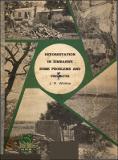| dc.contributor.author | Whitlow, J.R. | |
| dc.coverage.spatial | Zimbabwe. | en |
| dc.date.accessioned | 2016-03-08T15:54:15Z | |
| dc.date.available | 2016-03-08T15:54:15Z | |
| dc.date.issued | 1980-09 | |
| dc.identifier.citation | Whitlow, J.R. (1980) Deforestation in Zimbabwe: some problems and prospects, A Research Report. Harare: NRB/UZ. | en |
| dc.identifier.uri | https://opendocs.ids.ac.uk/opendocs/handle/20.500.12413/9911 | |
| dc.description | A research report on De-forestation problems in Zimbabwe. | en |
| dc.description.abstract | Whilst the deliberate clearance of woodlands In Zimbabwe possibly dates from the arrival of Iron Age hunters and shifting cultivators several centuries ago (West, 1973), it is only since the mid-twentieth century that deforestation has | reached such proportions as to constitute a major ecological and economic problem. This is due, in part, to a massive increase in the human population' from about 2,7 million in 1950 to over 7 million in 1980.
With the prospects of a possible doubling of this population within the next twenty years, the problem of the depletion of woodland resources is clearly a matter of national concern and of direct relevance to general development programmes, especially in rural areas.
The purposes of this report are:
(a) to draw attention to some aspects of the causes and consequences of the destruction of woodlands in Zimbabwe;
(b) to indicate some possible solutions to one of the main consequences of deforestation, notably shortages of wood-fuel.
A major theme will be on the problem of diminishing supplies of firewood. This is done for two reasons. Firstly, firewood constitutes the main use of the 6 million cubic metres of wood currently consumed each year in Zimbabwe and derived mainly from indigenous woodlands; and secondly, the majority of the African population in both rural and urban areas are dependent to a very large extent on wood as a primary source of fuel for cooking and heating. One must, however bear in mind that deforestation can give rise to shortages of a variety of other products including building materials and foodstuffs, but shortages of these are generally less critical at present than those relating to firewood. | en |
| dc.description.sponsorship | The research on which this report is based was funded by the Natural Resources Board and the Forestry Commission of Zimbabwe. | en |
| dc.language.iso | en | en |
| dc.publisher | National Resources Board (NRB) / Department of Geography (UZ) | en |
| dc.rights.uri | http://creativecommons.org/licenses/by-nc-nd/3.0/ | en |
| dc.subject | Environment | en |
| dc.title | Deforestation in Zimbabwe: some problems and prospects | en |
| dc.type | Other | en |
| dc.rights.holder | University of Zimbabwe (UZ) | en |


